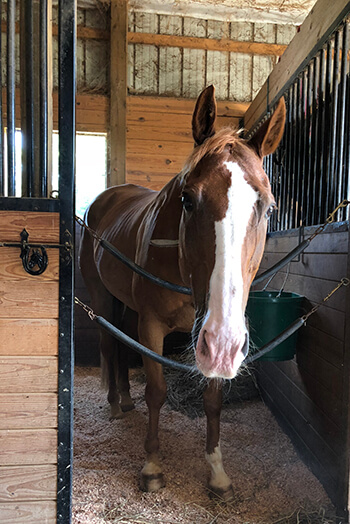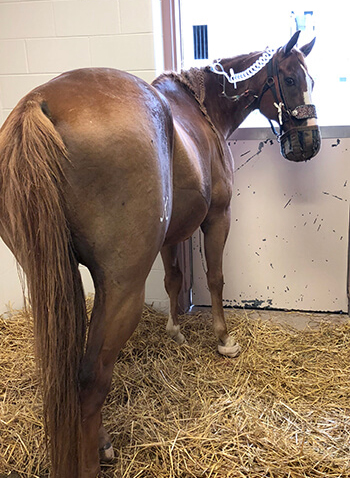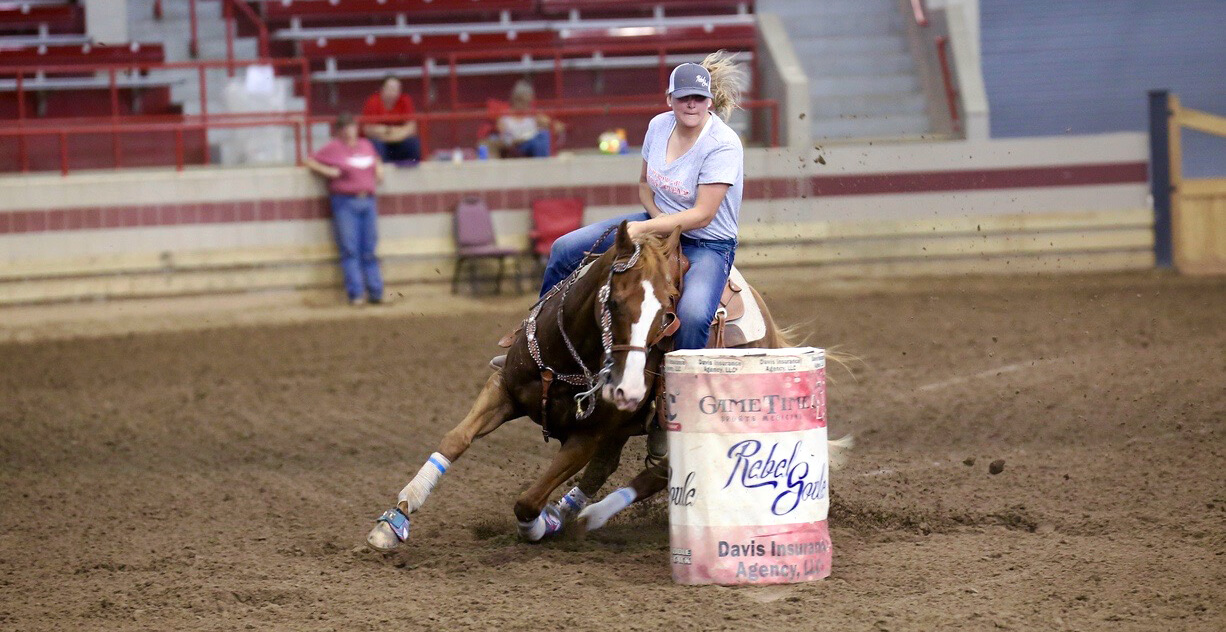 Robbie at home, comfortable and back to himself, post-colic surgery.
Robbie at home, comfortable and back to himself, post-colic surgery.
Stephanie Rzeplinski grew up around horses in rural Pennsylvania. Since age 4, she’s ridden and cared for the animals daily—so when her 13-year-old gelding, Robbie, fell ill, she immediately noticed something was wrong.
“I went to check on him at the end of the day, and he was just lying there on his side in the paddock, rolling around. When I came near him, he didn’t get up like he usually does. I thought, uh, oh – that’s not like him.” she said.
Rzeplinski suspected her beloved horse was in the early stages of colic, a broad term that covers most equine intestinal discomfort, but can sometimes be the symptom of a life-threatening disorder. She immediately brought Robbie to her vet, who confirmed her fears—a rectal exam showed that her horse’s intestines were distended, and no amount of pain medication seemed to help. Robbie would need to go to Penn Vet’s New Bolton Center, almost two hours away from Rzeplinski’s home, for emergency treatment.
She arrived to a flurry of activity. Dr. Maia Aitken, one of New Bolton Center’s specialized Emergency and Critical Care clinicians and board-certified surgeon, and a team of four other veterinary staff immediately coaxed Robbie from his trailer and began an examination.
“We do a comprehensive work up-on every colic case that comes through door,” said Aitken. “A horse’s small intestine can be 60-70 feet long. If the colic is being caused by some of that getting blocked or twisted, the intestinal tissue can become devitalized and die very quickly.”
Aitken recommended surgery to find and fix the problem, which seemed to be getting worse. After going in, she says, she saw that nearly 60 feet of Robby’s small intestine was in danger. “The main artery that supplies blood to the small intestine was twisted around, almost like a tourniquet,” she said. “It was very serious. Robbie was very lucky that Steph noticed his condition and took action immediately. Had she waited a day, we might not have been able to save him.”
 Robbie rests comfortably in the colic wing of the
Robbie rests comfortably in the colic wing of the
James M. Moran, Jr. Critical Care Center.
Resting comfortably in the colic wing of the James M. Moran, Jr. Critical Care Center – New Bolton Center’s state-of-the-art, bio-secure facility - Robbie, for his part, seemed unfazed by his ordeal. The morning after the surgery, Aitken said, he seemed to bounce back immediately, recognizing and greeting his owner in his recovery stall. Within a week, he was back in Rzeplinski’s paddock, happily chomping on hay.
“I was nervous about putting him through surgery, but they definitely took care of him,” said Rzeplinski. “New Bolton is the place to go if you need something like this for a horse. They have the best of the best, so I knew he was in good hands,”
“I understand her hesitation,” added Aitken. “People always worry about putting their horse through colic surgery, but it’s less of a big deal than clients think. The colic is the painful part, not the surgery. Our end goal here is not just to save horses’ lives, but also to get them back to same quality of life they had before their colic episode started—no matter if they’re a triple crown winner, a dressage champ, someone’s beloved trail horse, or someone’s beloved pasture pet.”
 Rzeplinski and Robbie turning a barrel in the pattern. Robbie is her strongest and most promising mount.
Rzeplinski and Robbie turning a barrel in the pattern. Robbie is her strongest and most promising mount.